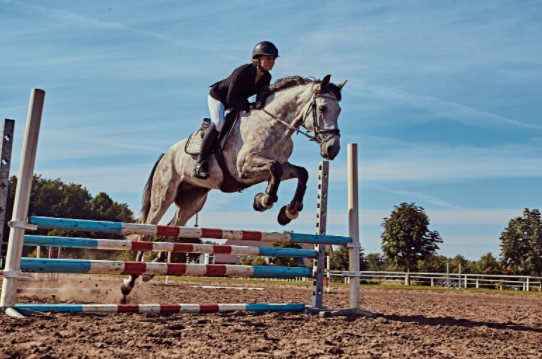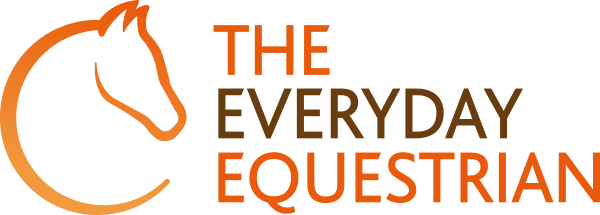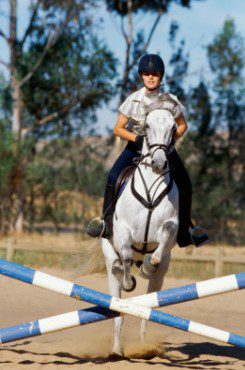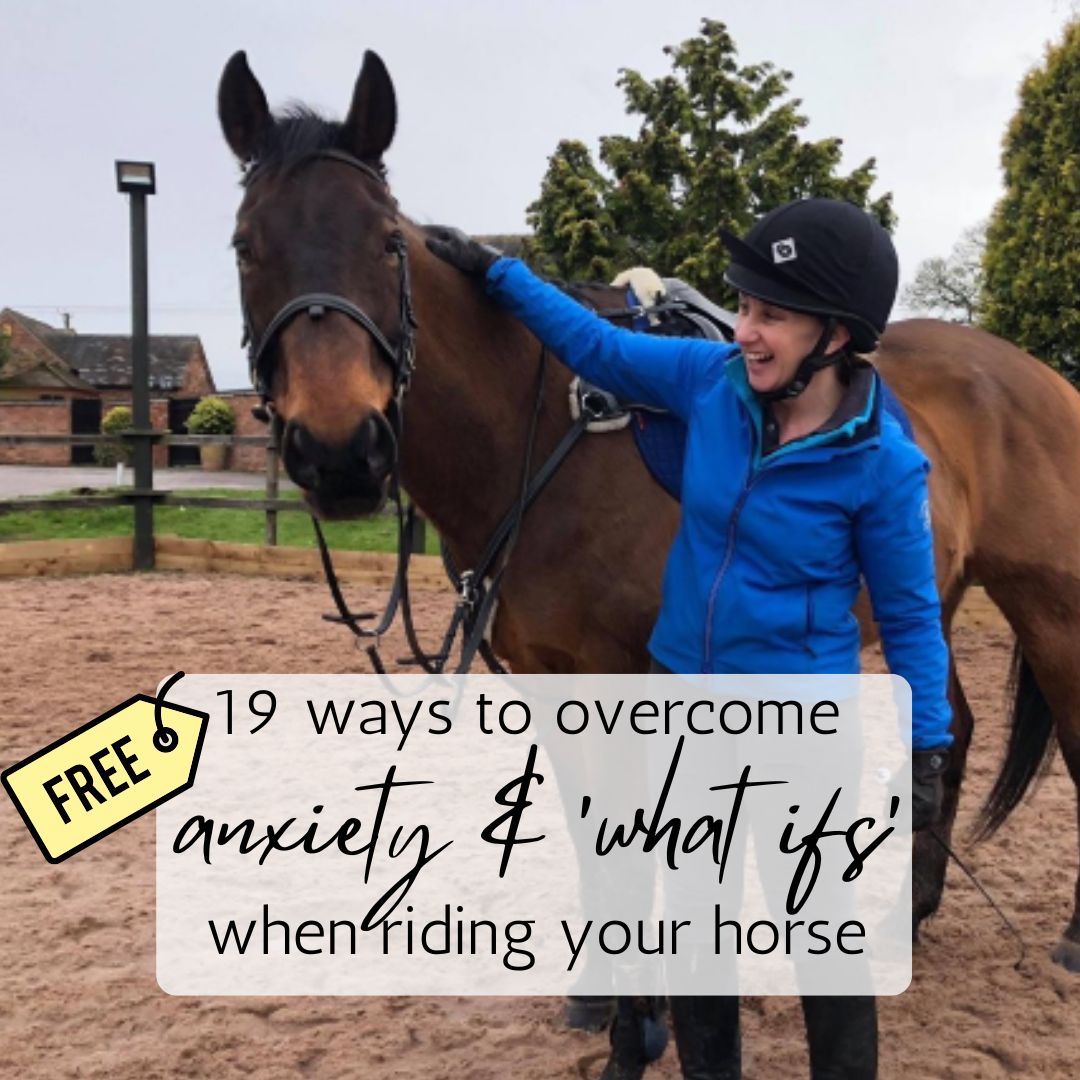
Jumping your horse can be exhilarating and loads of fun however many riders are scared to jump their horses. It is more common than you may think and even the most competent of riders can often be nervous about leaving the ground.
Navigating jumps adds a physical element into the mix which does not always sit right with some riders and can cause fear and anxiety at just the thought of it. A scared or nervous rider does not always bring out the best in their horse and can often affect how their horse reacts to certain situations.
Jumping requires an element of commitment from you which can be difficult to achieve when you are feeling uneasy.
Let’s take a look at some of the reasons why you may be scared to jump your horse:
- A refusal (which could lead to you falling off)
- Falling off and injuring yourself badly
- Feeling out of control
- Knocking the jump and your horse tripping
- Your horse jumping too big
- Getting the correct striding
- Landing and taking off
- Feeling unbalanced over the jump
These are some of the most common fears when it comes to jumping, but I am sure you can add your own personal fears to this list too.
So, how do I overcome my fear of jumping?
There are many ways in which you can help improve your confidence when jumping and eliminate the fear you are feeling. Let’s take a look in more detail of ways you can help combat these fears and enjoy jumping your horse.
Balance
The rider’s balance plays a very significant role when jumping. Having good balance helps you feel far more secure in the saddle whilst jumping which in turn can really help with your confidence. One of the best things to do is to start improving your balance, control and confidence on the flat first. After all, a large proportion of jumping is in fact flatwork!
The 5 Stages of Jumping
Having some background knowledge about the 5 stages of the horse’s jump can be very helpful for learning and progressing with your jumping. It can help you fully understand where both horse and rider should be at each stage of the process, which in turn can help you feel more prepared and less anxious. Each stage can be practiced and developed so that both horse & rider become more confident and proficient.
Position
Your riding position whilst jumping is also an important factor to consider. It takes time, patience, a good level of fitness and lots of practice to be able to adopt a strong, secure jumping position position, and to be able to transition between it and your position on the flat between jumps. Practising your jump position on the flat and over poles before you start actually jumping, will help you build the balance, fitness & security you need to jump with confidence.
Fitness and Strength
Fitness levels and strength play quite a bit part in jumping. Having a good level of fitness can allow you to stay strong and balanced in the jump position which can be challenging for riders until they have trained their bodies to do so. Build fitness and strength by maintaining a jumping position on the flat through walk, trot and canter, without sitting down!
Polework
Polework exercises can be a great foundation for jumping. The use of poles can help you build your confidence ready for jumping and can be used at all 3 paces (walk, trot and canter). Build your confidence over poles on the ground (walk, trot and canter). If you are looking for some inspiration on how to include polework in your horse’s training, click HERE!
Raised Poles
Once you have spent some time practising over flat poles and are feeling a bit more confident start to progress to raised polework exercises. Each pole can be raised slightly off the ground on one side and you can work through the line of poles in both trot and canter.
Keep it simple – use cross poles
Keeping it simple, to begin with, is key. You don’t want to overwhelm yourself or your horse from the get-go. Start by jumping fences that are small and simple. This will allow you more headspace to think about your technique rather than worrying about height. Cross-pole jumps are ideal and a great way to help you and your horse stay central and build good technique. Build up your repertoire of jumps and combinations steadily over time, progressing only when you are feeling confident and comfortable at the level.
Jump from working trot
It is OK not to canter into jumps right away despite what you may have been told. Jumping from a good working trot can be just as effective and allows you the time to build the correct technique, and develop your skills. Approaching a jump in trot can be a great confidence booster and less intimidating than a canter approach whilst you are learning.
Schoolmasters
Not all of us own a ‘been there and done it’ type. Your horse may be quite green when it comes to jumping and this will often do nothing for your confidence levels. Having some lessons on a schoolmaster will help boost your confidence. It will allow you the ability to fully concentrate on your own riding without having to worry about any silly behaviour or inexperience from your horse which can be off-putting.
Green and inexperienced horses
If your horse is inexperienced or having difficulty jumping, one of the very first things you must do is rule out any pain related issues that might be causing your horse to feel anxious. Secondly, ask an experienced rider to help school him/her to build the horse’s confidence and correct technique. An inexperienced horse and rider combo can sometimes be like the blind leading the blind.
Lessons
I just want to put this out there, reaching out for help is ok! Many of us try to battle through our riding and confidence issues on our own and that isn’t always the most productive way. Getting some lessons on your horse, with a qualified and experienced Equestrian Coach is a great support network and can really help you progress and overcome your fear of jumping.
Technique over height
Jumping with the right technique is far more important than the size of the jumps you are trying to navigate. Aim to build correct technique rather than becoming obsessed with the height of the jumps. Jumping well has an awful lot to do with the quality, adjustability and balance of your horse’s canter, so make this a priority.
Video analysis
Having someone video you whilst you are jumping can be a great tool (if you can find someone to do so). Video footage will allow you to come away from the situation so that you can look back and compare what it felt like with what actually happened. Often you will find it looks a lot better than it felt which can be a great confidence booster.
Canter Poles
When the time comes and you want to start progressing and cantering into your jumps, it can be a great idea to start from the ground up again. Use canter pole exercises to build your confidence in jumping from the canter. As you become more confident you can start to progress to raised poles.
Be one step ahead
You must be one step ahead when jumping which is particularly true if you are trying to navigate a showjumping course. Remember, the landing after one fence is the start of the approach to the next. ALWAYS be looking for your next jump!
Shorten your stirrups
Security in your lower leg is essential when jumping and for this reason, you must shorten your stirrups. It is correct to shorten your stirrups at least couple of holes before jumping which will provide you with more lower leg stability and allow you to get into the correct jumping position.
Mindset and Confidence Coaching
If you are struggling with your confidence either with jumping or general riding then why not book some sessions with a Rider Mindset and Confidence Coach? They will be able to help you manage your fears and create an empowered, positive mindset when riding.
Lastly, and certainly not least……
Remember, jumping is supposed to be fun for both you and your horse! If it’s not, go back to basics and take smaller steps towards your goal.


